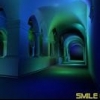The program produces basic, organ-like tones (including square/sawtooth waves). There are 12 different signals the user can toggle on/off by clicking the small squares in the top 2 panels. They can also adjust the envelope on each signal (the blue arrows) and zoom in/out of the waveform using the small blue sliders at the very bottom.
I'm eventually aiming for realistic-sounding instruments such as bells and pianos, but obviously I'm a long way off at the moment. No problem.
The sound is stored as an array of [font="Courier New"]short[/font] values. What I'm looking for is a way to apply a reverb effect to this without causing a ridiculous amount of feedback when the frequencies coincide. What I tried was this:
[source lang="cpp"]
for (int i = 0; i < soundArraySize; ++i)
if (i > 350)
soundArray += soundArray[i - 350] * 0.85f;
[/source]
Making 0.85f lower results in no effect, keeping it makes certain frequencies resonate with the reverb and go crazy. I just want a simple echo so instruments fade out instead of stopping sharply. How is it normally done?
Edit: Would this be more suitable in a different forum?







